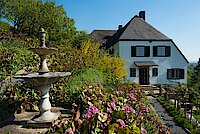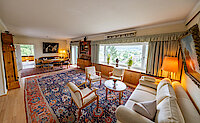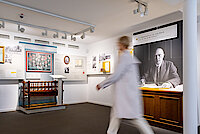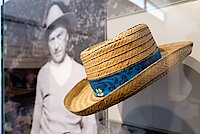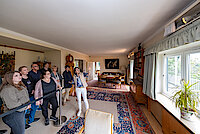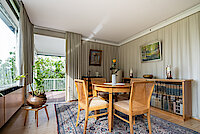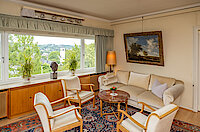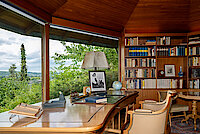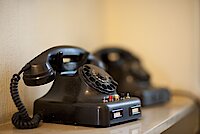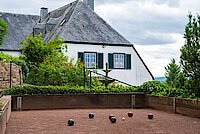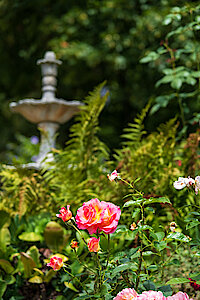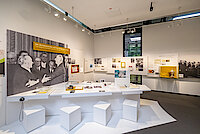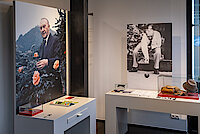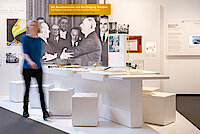Adenauerhaus Rhöndorf
In Adenauerhaus Rhöndorf contemporary history becomes an unforgettable experience! Anyone wanting to take a stroll through Konrad Adenauer’s garden, enjoy the spectacular view over the Rhine Valley and see how the first chancellor lived is in the right place here.
The combination of the historic house and garden with an exhibition in which you can experience Adenauer’s long life through fascinating artefacts and media makes Adenauerhaus a unique museum.
Visits
We look forward to your visit! You can find all information on opening hours, directions and other general conditions here:
Guided Tours and workshops
You want to visit Adenauerhaus with a group? Our guided tours and workshops are free and are suitable for all generations and school types.
The house

How Adenauer lived
With their private atmosphere, creaky parquet flooring and ticking grandfather clocks, the living quarters allow you to immerse yourself in the bourgeois living culture of the 1950s. Historic furniture, paintings and many personal memorabilia tell the story of Konrad Adenauer, who spent time here recuperating from his political labours.
Adenauer moved into the house just before Christmas 1937. After the National Socialists had driven him out of his own town, the former Mayor of Cologne found a new home in the countryside for himself and his large family.
From 1949 the house was a private retreat for the chancellor, but also the scene of groundbreaking political events: At the “Rhöndorf Conference” politicians from the CDU and CSU set the course for the Federal Republic’s first governing coalition. In 1962, Adenauer received the French president Charles de Gaulle here.
During a guided tour you can visit the living quarters on the ground floor. Other rooms such as the “cabin”, originally a terrace that was later roofed over and incorporated in the house, as well as the dining room and the bedroom can be seen from outside.
The garden
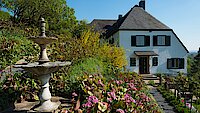
Adenauer’s green paradise
A colourful variety of trees, shrubs and flowers bloom in the terraced garden. The high-stemmed scented roses favoured by Adenauer dominate.
With Mediterranean plants, baroque sculptures and fountains, the garden is reminiscent of northern Italy. In Cadenabbia on Lake Como, where Adenauer regularly spent his holidays from 1957, the chancellor learnt how to play bocce. He was so fascinated by it that he had a bocce alley built in his garden in Rhöndorf.
Adenauer also got the idea of building a pavilion from Cabenabbia. After resigning from the office of chancellor he drew the sketches for the summerhouse himself in 1964. Adenauer wrote his memoirs at his desk there.
The exhibition
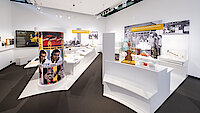
Konrad Adenauer 1876-1967. Rhinelander, German, European
The exhibition takes visitors on a journey through almost 100 years of German history, from the German empire through the Weimar Republic and National Socialism to the era of the Federal Republic. It shows the politician and statesman, but also Konrad Adenauer the family man, gardening enthusiast and inventor.
Adenauer’s long life is presented with more than 500 exhibits, videos, pictures and media stations over an area of 300 m². Text boards explain the historical context and allow Adenauer to have his say in quotes. The focus is on three central reference points: Adenauer as Rhinelander, German and convinced European.
A visit to the museum encourages reflection and discussion: Space is given to fellow campaigners, opponents and protests as well as critical and controversial topics. The exhibition can be explored with a media guide.
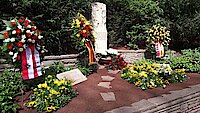
The Foundation Chancellor-Adenauer-House maintains the grave of the Adenauer family at the Waldfriedhof in Rhöndorf. Konrad Adenauer was laid to rest here after his death on 19 April 1967. Wreath-laying ceremonies are held in memory of Adenauer on the anniversary of his death and on his birthday on 5 January.
It is about a 15-minute walk from Adenauerhaus through the centre of Rhöndorf to the Waldfriedhof. The path is very steep at the top and requires a certain level of fitness and sturdy footwear.
In the centre of the idyllic wine village of Rhöndorf at the foot of the Siebengebirge mountains, Adenauer's house is located in a beautiful region with plenty to see and do. There are also other places connected to Konrad Adenauer and to the history of the Federal Republic of Germany.
On Rhöndorf’s Ziepchensplatz, Café Profittlich commemorates Adenauer’s dispute with the confectioner and master baker Peter Profittlich over the construction of a cable car up the Drachenfels, which the founding chancellor decided in his favour.
At the Broel winery, Adenauer discussed the new democratic beginning after 1945 over many a glass of wine with fellow politicians from the North Rhine-Westphalian CDU.
The early years of the Federal Republic are inextricably linked with the Petersberg location: The Allied High Commissioners had their headquarters here. Adenauer’s inaugural visit as Federal Chancellor went down in history as Adenauer’s ‘carpet diplomacy’. Since the 1950s the Federal Republic of Germany has hosted its state guests on the Petersberg.
The ceremonial opening of the Parliamentary Council took place in the Koenig Museum in 1948. After his election as Federal Chancellor, Adenauer first moved into the office of the museum director before the chancellery could be set up in Palais Schaumburg.
The Haus der Geschichte makes the historical sites of the Bonn Republic accessible to the public on the Bonn Path of German Democracy. These include Palais Schaumburg, the Chancellor’s Bungalow and the Bundesrat (Upper House).
You can find other excursion destinations and activities in the Siebengebirge mountains.
